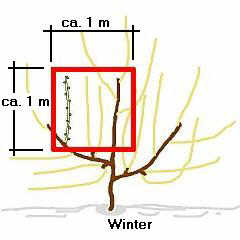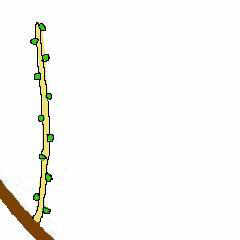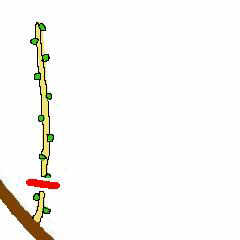Spur Pruning
Spur pruning -- 'short pruning' -- is the simplest of the pruning techniques. The principle of short pruning is to form spurs, branches with 2-3 buds (or even only 1 with some very vigorous varieties). The description here is for fully trained grapevines. Please refer to the section on Training for 1st - 3rd year grapevines first!
Spur pruning is suitable for many grape varieties, although it often fails in older varieties or very vigorous, young plants. They will produce abundant foliage but no fruit, because the buds close to the stem have no fruiting buds. In this case, the spurs need to be pruned slightly longer, i.e., with 3 - 5 eyes; otherwise, switch to rod pruning.
The following diagrams illustrate the training and pruning based on a selected side shoot position over several years. Spaced approx. 25 - 50cm apart are numerous other side shoots arising from the trained main stems (Diagram 00). Within the frame (red), the stem wood (dark brown) in the left bottom corner grows diagonally. The spur pruning described below is not influenced by that, and the diagrams also apply to vertical or horizontal stems.
The diagrams in the column to the left illustrate the side shoot after leaf fall in winter, and Pre- Pruning of the old wood (dark brown). These canes have been summer pruned; otherwise, they would be much longer now. Each cane produced approx. 1 - 2 grape bunches in summer. The diagrams in the central column depict the pruning of the fruiting canes into the wood from the previous year (ochre); the diagrams in the column to the right show the results.

Diagram 04: The most important principle in spur pruning: the shoot positioned further away from the main stem is cut off completely, including about 5mm of the old wood (pre-pruning back into the dark brown old wood). This way, the side shoot - which is gradually becoming gnarled over the years - remains close to the main stem, and its life span is extended. If a third shoot has grown from the axil, then the upper two of the three light coloured shoots are completely removed.













